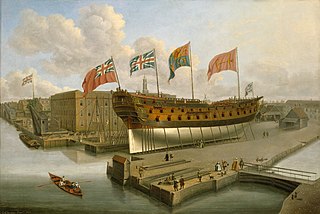The Royal Navy has used the name Comet no fewer than 18 times:

HMS Liverpool was a 28-gun Coventry-class sixth-rate frigate of the Royal Navy. Launched in 1758, she saw active service in the Seven Years' War and the American Revolutionary War. She was wrecked in Jamaica Bay, near New York, in 1778.

HMS Lichfield was a 50-gun fourth rate ship of the line of the Royal Navy, built at King's Yard in Harwich by John Barnard to the dimensions laid down in the 1741 proposals of the 1719 Establishment, and launched on 26 June 1746. She was wrecked on the Barbary Coast of North Africa on 28 November 1758.

HMS Argo was a 28-gun sixth-rate frigate of the Royal Navy. The ship was one of the Coventry class, designed by Sir Thomas Slade as a development of based on HMS Lyme, "with such alterations as may tend to the better stowing of men and carrying for guns."
HMS Shrewsbury was a 74-gun third-rate ship of the line of the Royal Navy, launched on 23 February 1758 at Deptford Dockyard.

HMS Duke was a 90-gun second-rate ship of the line of the Royal Navy, launched on 13 June 1682 at Woolwich Dockyard.

The Foudroyant was an 80-gun ship of the line of the French Navy. She was later captured and served in the Royal Navy as the Third Rate HMS Foudroyant.

HMS Thames was a 32-gun Richmond-class fifth-rate frigate of the Royal Navy built by Henry Adams and launched at Bucklers Hard in 1758. She served in several wars, including for some four years in French service after her capture. She was recaptured in 1796 and was broken up in 1803.

HMS Essex was a 70-gun third rate built by Sir Henry Johnson of Blackwall in 1678/79. During the War of the English Succession she fought in the last major action. She was rebuilt in 1699/1700. During the War of Spanish Succession she fought at Vigo Bay, the Capture of Gibraltar and Velez Malaga. She also fought at the Battle off Passero in 1718. She was rebuilt again in 1736-40. She was in action off Toulon in 1744. She was active in the Channel and against French ports during the Seven Years War. She fought at Quiberon Bay in 1759. She was wrecked in Quiberon Bay in November 1759.

HMS Swiftsure was a 70-gun third-rate ship of the line of the Royal Navy, launched in 1755 and in active service during the Seven Years' War. After a distinguished career at sea she was decommissioned in 1763 and sold into private hands ten years later.

HMS Gloucester was a 50-gun fourth rate ship of the line built for the Royal Navy in the 1740s. She participated in the 1740–48 War of the Austrian Succession, capturing four French privateers. The ship was broken up in 1764.

HMS Buckingham was a 70-gun third-rate ship of the line of the Royal Navy, built at Deptford Dockyard by John Holland to the draught specified by the 1745 Establishment, and in active service during the Seven Years' War with France. With a crew of 520 she was one of the largest ships in the Navy at that time.
HMS Burford was a 70-gun third rate ship of the line of the Royal Navy, built at Chatham Dockyard to the draught specified by the 1745 Establishment as amended in 1754, and launched in 1757.

HMS Cerberus was a 28 gun sixth-rate frigate of the Royal Navy.

HMS Venus was the name ship of the 36-gun Venus-class fifth-rate frigates of the Royal Navy. She was launched in 1758 and served for more than half a century until 1809. She was reduced from 36 to 32 guns in 1792. She was sold in 1822.

HMS Pallas was one of the three 36-gun Venus-class fifth-rate frigates of the Royal Navy. She was launched in 1757 and initially served in Sir Edward Hawke's fleet blockading the coast of France where she fought at the Raid on Cherbourg and in the Battle of Bishops Court. She later served for a number of years in the Mediterranean Sea before moving to serve off the coast of Africa between 1774 and 1776 where she protected the isolated British colonies. In 1778 she joined the Newfoundland Station and participated in the attack on Saint Pierre and Miquelon. Pallas returned to the English Channel after this and assisted in destroying a French invasion force intended for the Channel Islands in 1779 before briefly serving on the Jamaica Station. In 1783 she was beached on São Jorge Island after she was found to be heavily leaking; she was burned there on 24 February.

HMS Maidstone was a 28-gun Coventry-class sixth-rate frigate of the Royal Navy. She was launched in 1758 and taken to pieces in 1794.

HMS Active was a 28-gun Coventry-class sixth-rate sailing frigate of the Royal Navy, launched in 1758. She was one of the captors of the Spanish ship Hermione. After Hermione surrendered, her captors found that she carried a large cargo of gold and silver that would lead to the greatest single amount of prize money awarded to the crew of a British warship.

HMS Aquilon was a 28-gun Coventry-class sixth-rate frigate of the Royal Navy. Launched in 1758, she saw active service against the French during the Seven Years' War, capturing seven enemy vessels in the first eight months of 1761. She was declared surplus to Navy requirements and sold into private hands in 1776.

Abénaquise was a 36-gun ship of the French Navy of the Ancien Régime, designed by René-Nicholas Lavasseur and launched on 8 July 1757. She was commanded by captain Gabriel Pellegrin. In 1757 she crossed the Atlantic Ocean in 38 days. This was one of the fastest crossings from Brest to Petite ferme on the Côte de Beaupré with pilot Pellegrin, port captain of Quebec, who was on his forty-second crossing.















